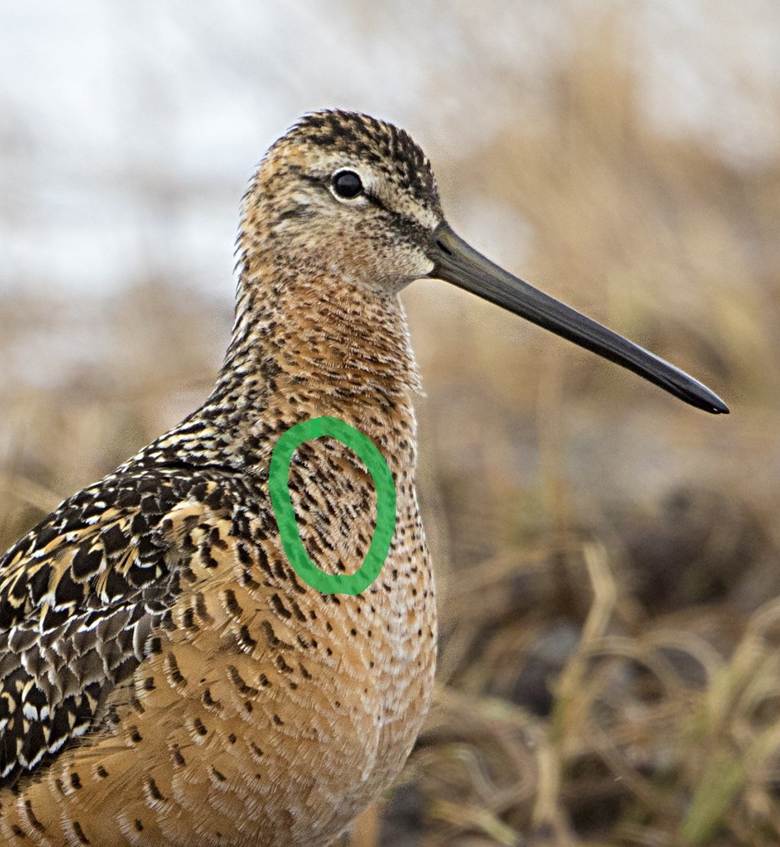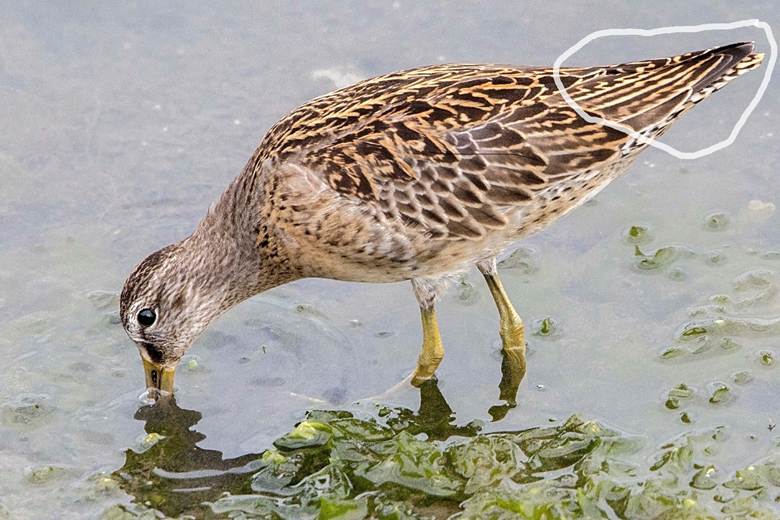In this post I am going to discuss a few fieldmarks for
separating the two dowitcher species from each other. I will start with adults
in alternate plumage and then discuss juveniles. The two species are extremely
similar in basic plumage and given the rarity of Short-billed Dowitcher in the
county in winter, I am not going to discuss the slight differences in detail.
You should always try to confirm a winter Short-billed Dowitcher by call.
To reduce the learning curve, I will be covering a subset of
the available fieldmarks and focusing on ones I find especially useful or easy
to use.
Alternate Plumage
When first viewing an adult dowitcher in alternate plumage,
I start by assessing the overall tone of the reddish underparts and how
extensive this coloration is on the underparts. In Long-billed the underparts
tend to be more brick-red and this color extends all the way through the vent.
Short-billed, on the other hand, has more orange-toned underparts and this
coloration extends to belly, but the vent and rear flanks are white. The local
subspecies of Short-billed Dowitcher also tends to average heavier dark flank
barring, which is accentuated by the whiter background. However, note that
Long-billed Dowitcher, especially in spring, can often show heavy flank barring
as well.
Once I have used the above criteria to make a provisional
identification, I then try to confirm the identification by looking at the
sides of the upper breast/lower foreneck. These have short dark-barring in the
case of Long-billed Dowitcher and dark spotting in the case of Short-billed.
This feature seems to survive plumage wear on the breeding grounds and is
usable in both spring and fall migration. Note that, especially in spring, both
dowitcher species can show spotting and barring on much of the underparts, so
it is critical to look in the correct place. I have highlighted exactly where
to look in the photographs below.
Three alternate (or mostly alternate) Long-billed
Dowitcher (BH). Note the more brick-red tone to the underparts and short
dark barring on the sides of the upper breast/lower foreneck (ringed in green).
Avoid getting distracted by spotting on the center of the breast/foreneck.
Juvenile Plumage
In juvenile plumage, there is a significant average
difference in the brightness of the overall appearance of the two species, at
least by the time they reach Santa Barbara County. This is due to two factors:
firstly, Short-billed Dowitchers are brighter on average; secondly, Long-billed
Dowitchers have a more rapid molt from juvenile plumage and are more advanced
into (duller) basic plumage when they arrive in the county.
In particular, the orange-buff markings on the back and
scapulars (and tertials and greater-coverts and even the crown) are more
extensive on the Short-billed Dowitcher.
In contrast, these feathers on juvenile Long-billed have duller darker
rufous markings that are also less extensive on average. The net result of this
is that at long range, juvenile Long-billed tends to look rather dull and
uniform above, whereas juvenile Short-billed shows an obvious bright ‘saddle’
or back. I do occasionally see a juvenile Long-billed with more extensive and
more buffy scapular markings, very similar to those of Short-billed, but such
birds are a small minority.
A second factor impacting the relative brightness of
juveniles is the breast and upper flank color. Juvenile Short-billed is usually
extensively buffy, sometimes very bright. While these buff tones are subject to
fading from mid-September onwards, they are typically brighter even then than
most Long-billed Dowitchers. Juvenile Long-billed tends to have more restricted
buffy tones and often quickly molts the breast to the gray of basic plumage,
generating an even duller appearance.
Two juvenile Short-billed Dowitchers (ringed in orange)
and two juvenile Long-billed Dowitchers (ringed in white) (PS). Although
these Short-billed Dowitchers are rather faded this late in the season
(October), note the orange-buff spots in the tertials, the brighter and more
extensive orange-buff markings on the back and the more obvious buff wash on
the breast.
Beyond the general brightness, the specific “go-to” feature
to separate juvenile dowitchers is the pattern of the tertials. On Long-billed
Dowitcher, the tertials are plain unmarked gray with a very narrow pale fringe.
On Short-billed, the tertials are gray-brown with some orange-buff internal
markings.
Juvenile Short-billed Dowitcher (BH). Note the
obvious orange-buff markings in the tertials (ringed in white)
Juvenile Long-billed Dowitcher in transition to basic
(PS). Note the plain gray tertials with a narrow pale fringe (ringed in white).
These are the juvenile tertials, not basic ones. Generally, the tertials seem to
be among the last juvenile feathers to be lost on both species.
As ever with these two species, there are some caveats with
this feature. I have on a couple of occasions seen juvenile Long-billed
Dowitchers show a few small reddish dots or dashes just inside the edges of the
tertials. This is so infrequent that you can assume that a juvenile dowitcher
with internal markings on the tertials is a Short-billed. If these markings are
minimal and the bird has other features favoring a Long-billed, then I would
suggest trying to hear the bird vocalize.
More problematic are juvenile Short-billeds with relatively
or very indistinct markings in the tertials. Very rarely (certainly <1%) I
have come across juvenile Short-billed Dowitchers with completely unmarked
tertials. Much more frequent (10-15% of juveniles) are birds where the internal
markings are quite dull and are difficult to see at medium-to-long range.
However, the markings are there if you can get good looks or photographs.







Comments
Post a Comment